- Home
- Terry Pratchett
Turtle Recall: The Discworld Companion ... So Far Page 15
Turtle Recall: The Discworld Companion ... So Far Read online
Page 15
He feels that it is not his fault that perfectly sound business propositions have a habit of exploding or tasting awful.
Dibblers have turned up in various parts of Discworld, which just shows the effects of parallel evolution. Wherever there are people prepared to eat terrible food, there will be someone there to sell it to them. These incarnations have included:
Al-Jiblah [J]
Dib Diblossonson [TLC]
DISEMBOWEL-MESELF-HONOURABLY DIBHALA [IT]
Fair Go Dibbler [TLC]]
May-I-Be-Kicked-In-My-Own-Ice-Hole Dibooki [TLC]
May-I-Never-Achieve-Enlightenment Dhiblang [TLC]
Swallow-Me-Own-Blowdart Dlang Dlang [TLC]
Dibbler, Solstice (‘Soll’). C. M. O. T. DIBBLER’S nephew. Was heavily involved in the moving picture industry, where he showed a business acumen very nearly equal to that of his uncle. But he has a more modern outlook. Should mobile phones ever be invented on the Discworld, one feels, then Soll will be the first to have one (although he will not have anyone to talk to, of course). [MP]
Didactylos. Ephebian philosopher. This short, bald, blind man in a grubby toga and with a petulant, reedy voice is nevertheless one of the most quoted and popular philosophers of all time. His wise sayings are quoted throughout the multiverse (and include such axioms as ‘There’ll be another one along in a minute’, ‘It’s a funny old world’, ‘It’ll all end in tears’, ‘You cannot trust the bastards an inch,’ and so on). At one time he carried a lantern, telling people that he was looking for an honest man, but this was probably just a pose and an attempt to get money. He lives in a barrel and would probably benefit from bathing rather more often, or at all.
He reasoned that if the Disc is 10,000 miles across and light travels at about the speed of sound, then the sun has to travel at least 35,000 miles in its orbit every day, or twice as fast as its own light. This means that it is, from the standpoint of modern physics, a tachyon (a scientific term meaning magical thing).
He was made a bishop of the Omnian church despite not believing in any gods, although this is perfectly OK for a modern bishop. [SG]
Dijabringabeeralong. Major town in Xxxx, reached by a wooden bridge over the bone-dry Lassitude River. There is a huge windmill on a metal tower with the words: ‘Dijabringabeeralong: Check Your Weapons’ that is to say, check that they work. The sign is important, because otherwise you might be unaware that you’d ridden through a town. The architecture could be described as ‘vernacular’, which means ‘made up, with a lot of swearing’. Dijabringabeeralong is famed for its Annual Regatta, cancelled on one famous occasion because the river filled up with water. [TLC]
Dil. Embalmer in the Kingdom of DJELIBEYBI. Thirty-five years’ experience in the funeral business. A solid and thoughtful man, with that tranquillity of mind and philosophical outlook that comes from spending most of your working day up to the elbows in a dead king. [P]
Dinwiddie, Dr. A. A., DM (7th), D.Thau, B.Occ, M.Coll, BF. The Bursar at Unseen University, Ankh-Morpork. Aged 71. The Bursar is kept on the right side of apparent sanity by a regular dosage of dried frog pills, which make him hallucinate that he is sane.
Dios. High Priest in DJELIBEYBI. First Minister and High Priest among High Priests.
Dios was (or is, or will be – certain temporal uncertainties make the choice of tense very difficult) a tall, bald man with an impressive nose. In his role as general adviser to the ruler he spoke (speaks, etc.) softly but carried a big stick, in this case his staff of office – symbolic snakes wrapped round an allegorical camel prod.
He ate (we will settle on the past tense) no meat, believing that it diluted and tarnished the soul, and lived for 7,000 years by regularly sleeping in a pyramid, which renewed him or, more accurately, recycled him. In fact it could be said that he was only 7,000 years old from the point of view of an external calendar; more realistically, he had for most of that time been living the same day over and over again. Since the palace days on Djelibeybi were a complex network of rigidly observed ritual, this suited him quite well. There was never any need to do anything differently.
Consequently he was a man of tradition and organisation – indeed, he considered that there are no things more important.
Dios, although a devout priest, was not a naturally religious man. He felt that it was not a desirable quality in a high priest; it affected your judgement, and made you ‘unsound’. He felt that the gods were necessary, but he required that they should keep out of the way and leave him to get on with things. [P]
Discworld, the. As all will know, the Discworld is a flat planet – like a geological pizza, but without the anchovies. It offers sights far more impressive than those found in universes built by Creators with less imagination but more mechanical aptitude. It exists right on the edge of Reality; the least little things can break through from the other side. It is allowed to exist either because of some impossible blip on the curve of probability, or because the gods enjoy a joke as much as anyone else. More than most people, in fact.
It was the Ephebian philosopher EXPLETIUS who first proved that the Disc was 10,000 miles across. It is about thirty miles thick at the Rim, although it is believed to be considerably thicker towards the Hub, possibly to accommodate the internal layer of molten rock which powers the volcanoes and allows the continental plates to move. Exactly how this molten state is maintained, and how the water that pours ceaselessly over the rim from the Circle Sea is replaced, are but two of the unfathomable mysteries of the world. A tenable theory is that the heat is generated by vast masses of octiron under pressure. The octiron theory also accounts for the Disc’s vast standing magical field.
Whatever the explanation, the fact is that the surface features of the Discworld uncannily mirror those of spherical rocky worlds, as though the Creator had seen one somewhere but had to go ahead without a chance to examine the works.
The continents certainly have moved around (possibly on wheels of some kind, if the molten rock theory is discounted). Discworld time is always a tricky thing to measure, but by inference it must have been several hundred million years ago that the supercontinent of Pangola was struck by a giant meteorite, which may have killed off those lifeforms not equipped by a neglectful Nature to survive impact with flaming rock travelling at several thousand miles a second, and also instigated the break-up which led eventually to the Discworld of today.
Inspection of residual magic in deep sea rocks and very old trolls suggests that it was also around this time that the Discworld first changed its direction of spin, a phenomenon that appears to occur every hundred thousand years or so, possibly for the comfort of the elephants.
About one hundred million years before the present day, in the period described by the wizard and geologist BORASS as the Borassic era, the proto-continent had clearly split into two vast land masses – Howondaland (named after the continent where his researches were largely carried out) and Lauragatea (partly named after the empire that occupies much of the Counterweight Continent, and partly after his mother). A generally confused banging-about as the spin direction changed raised most of the mountain ranges visible today.
It was the second, smaller continent of Lauragatea which, some thirty million years before the present, lost the even smaller and deeply mysterious continent known only as XXXX, which wandered off by itself (according to Borass) in search of the geographical equivalent of a cool drink.
Of course, it is only a theory. The truth might be stranger (see, for example, ELEPHANT, the Fifth).
Of course, none of this explains the sheer beauty of the whole thing . . .
Viewers from space can appreciate in full the Discworld’s vast, 30,000-mile circumference, garlanded by the long Rimfall, where the seas of the Disc drop endlessly into space. It gives the impression, with its continents, archipelagos, seas, deserts, mountain ranges, that the Creator designed it specifically to be looked at from above.
The Disc revolves at a rate of about once every 800
days. This means that, except at the Hub, a full astronomical year contains eight seasons, or two each of the classical four (see CALENDARS).
Its tiny orbiting sunlet, with prominences no bigger than croquet hoops, maintains a fixed elliptical orbit, while the Disc revolves beneath it. The little moon shines by its own light, owing to the cramped and rather inefficient astronomical arrangements.
The Hub, dominated by the spire of CORI CELESTI, is never closely warmed by the weak sun and the lands there are permanently locked in permafrost. The Rim, on the other hand, is a region of sunny islands and balmy days. From the RAMTOPS’ highest peaks you can see all the way to the Rim Ocean that runs around the edge of the world, since the Discworld, being flat, has no horizon in the real sense of the word.
There appear to be at least four major continental masses:
The (unnamed) continent of which the STO PLAINS and the Ramtops are a major feature: this stretches all the way to the Hub and finishes, at least in the area of Ankh-Morpork, at the CIRCLE SEA. Less than half of it has been covered in the chronicles, and there must be far more land on the far side of the Ramtops. So far we know only of GENUA and some miscellaneous small countries.
KLATCH (the continent): this is detailed elsewhere, but here and now we might not be far wrong in thinking of Klatch as the Discworld’s Africa, with a collection of ‘Mediterranean’ countries shading into the large, and more or less unexplored, plains of HERSHEBA and HOWONDALAND.
The COUNTERWEIGHT CONTINENT: smaller than either of the above, and occupied by an advanced civilisation.
‘XXXX’: the name as it appears on maps of the mysterious fourth continent, once reached by people from Ankh-Morpork, then lost, found again and, now, fully a part of Discworld and performing a valuable role in the supply of opera singers, bartenders, backpackers and so on.
There have been other continents, which have sunk, blown up or simply disappeared. This sort of thing happens all the time, even on the best regulated planets.
And there, below the mines and sea-ooze and fake fossil bones put there (most people believe) by a Creator with nothing better to do than upset archaeologists and give them silly ideas, is Great A’TUIN.
Chaotic as it sometimes appears, the Discworld clearly runs on a special set of natural laws, or at least on guidelines. There is gravity. There is cause-and-effect. There is eventuality – things happen after other things. After that, it becomes a little more confusing. The following theory can be gingerly advanced:
The Discworld should not exist. Flatness is not a natural state for a planet. Turtles should grow only so big. The fact that it does exist means that it occupies an area of space where reality is extremely thin, where ‘should be’ no longer has the veto it has in the rest of the universe. The Discworld creates an extremely deep well in Reality in much the same way as an incontinent Black Hole creates a huge gravity well in the notorious rubber sheet of the universe.
The resulting tension seems to have created a permanent flux which, for want of a better word, we can call magic. There are several secondary effects, because the pressure of reality is so weak. Things that might nearly exist in a ‘real’ world – back up there on the rubber sheet – have no difficulty at all in existing in quite a natural state in the Discworld universe; so here there will be dragons, unicorns, sea serpents and so on. The rules are relaxed.
But there are additional factors which make up Discworld ‘physics’. These could be called:
a) Life force
b) The Power of Metaphor and Belief
c) Narrative Causality
Life, it has been said, has a tendency to exist. It has even been argued that the Universe has been designed in order that this should happen, although of course it is hard for a life that does not exist to look around and declare that the Universe has clearly been designed not to come into being. Certainly on the Discworld life is a very common commodity. Whatever obstacles there are to life elsewhere are that much weaker on Discworld. Almost anything can be alive and develop, if not intelligence at least a point of view. Rocks, thunderstorms and even entire buildings can, in the right circumstances, demonstrate their literal vitality.
Then there is metaphor. On Discworld, metaphor has a disturbing tendency to take itself seriously. Death as a robed skeleton is not just a metaphor for the process of mortality; he really is a robed skeleton, with a rich existence of his own. On Discworld, belief is a potent force. What is believed in strongly enough is real. (Conversely, what is not believed can’t be real regardless of the fact of its existence. For example, the dog GASPODE can talk. But most people cannot hear him when he does because they know, in their soul, that dogs do not talk. Any dog that appears to be talking, says their brain, is a statistical fluke and can therefore safely be ignored.) Discworld gods exist because people believe in them, and their power waxes and wanes with the strength of that belief. There is nothing very magical in this. After all, half the power of witches – and wizards, too, for that matter – lies in the fact that they advertise what they are. The pointy hats are a kind of power-dressing; they’re no different from the white coats worn by any actor hawking washing powder. If people believe you can do magic you’re halfway there already.
Finally, there is narrative causality, the power of stories. This is perhaps the strongest force of all and, again, weaker echoes of it are found in this world. Not for nothing do we say: History repeats. History does have patterns, clichés of time. People find themselves again and again in situations where they are playing roles as surely as if a script had been thrust into their hands: the Marital Row, the Job Interview, the Man Behind has Shunted You at the Traffic Lights, the Bastard. And there are the bigger patterns: the rise of empires, the spread of civilisations . . . Again and again humans tread the same dance through life, and with each dance the path becomes deeper and harder to leave.
The sense of predestination permeates Discworld. History Monks observe history to make sure that it happens ‘according to the book’ (although now, thanks to the discovery of quantum uncertainty, it’s hard to know which book). When a princess is saved by MORT, History itself conspires to kill her. The process is focused in Lily WEATHERWAX, who forces the lives of people into stories – and also in DIOS, the high priest of DJELIBEYBI, who has been practising the same daily rituals for so long that he is incapable of dealing with anything new.
On Discworld, the future is written. The role of humans, thanks to bloody quantum, is to choose which book.
Dismass, Old Mother. Also called Gammer Dismass. Beryl Dismass’s clothes have the disarray of someone who, because of a detached retina in her second sight, lives in a variety of times all at once. [WS, WA, SALF]
Dis-Organiser, the. A little demon in a box which can be used to store information, appointments, record conversations and memos, etc. The more recent Mk 2 is advertised as the very latest in thaumaturgic design, although it is still guarded by an extremely carefully worded warranty.
The Mark V is known as the Gooseberry. It is now cased in a smart brown box, with a pointy-eared small green imp inside. The new version includes the handy-to-use Bluenose Integrated Messenger Service, the games of Splong and Guess My Weight in Pigs. iHum can remember up to 1500 of your all-time favourite tunes. [J, TT]
Djelibeybi. (The name means ‘Child of the Djel’, after the river which flows through this land.) Also called the Kingdom of the Sun and the Old Kingdom. Principal crops: melons, garlic and, since they are increasingly encroaching on the fertile agricultural land, pyramids.
Djelibeybi is two miles wide and 150 miles long and is on the CIRCLE SEA coast of KLATCH. Almost entirely underwater during the flood season and both threatened and protected on either side by stronger neighbours (TSORT and EPHEBE). It was once great, but all that now remains is an expensive palace, a few dusty ruins in the desert, and the pyramids. The entire economic life of the country is, until after the events of Pyramids, devoted to building them. As a result, Djelibeybi is permanently bankrupt.
The kingdom is 7,000 years old. In the Pyramid era, even the heat was old. The air was musty and lifeless, pressing like a vice. Time moved slowly in Djelibeybi, and even then only in circles.
And this was, once again, because of the pyramids. Pyramids slow down time and prevent decay, a fact known to ancient Egyptians and modern Southern Californians. So many had been built in the Old Kingdom, however, that their cumulative effect was to act as a temporal brake of major proportions. In fact (again until events chronicled in Pyramids) the thousands of pyramids in the necropolis, a city of the dead occupying some of the kingdom’s best land and second only to Ankh-Morpork as the biggest city on the Disc, were actually preventing time from moving at all. The pyramids were acting as time accumulators, sucking in fresh time as it occurred and, around sunset, flaring it off from their tips. As a result the kingdom spent thousands of years re-using the same day.
Please note that it was not the same as repeating the same day. People were born, grew and died (and, if they were important enough, they were placed in a pyramid). It was similar to the ‘time’ in DEATH’S domain. Plants grew and flowered. There was an ongoing history. But it took place, as it were, in the temporal equivalent of an unaired room – the stale time could be detected in the kingdom’s obsessive reverence for the past and its resistance to, or even ignorance of, the possibility of doing things differently. The more things changed, the more they stayed the same . . .
This impasse was finally broken with the construction of the Great Pyramid, which put so much additional pressure on the local dimensions that the entire kingdom was temporarily removed from them.
The country has an enormous number of local gods, unknown to the world outside. Its ruler, the Pharaoh, is also a god, although in human form. He wears a gold mask (the Face of the Sun) and during his official functions carries the Flail of Mercy, the obsidian Reaping Hook of Justice, the Honeycomb of Increase, the Asp of Wisdom, the Sheaf of Plenty, the Gourd of the Water of the Heavens, the Three-Pronged Spear of the Waters of the Earth, the Cabbage of Vegetative Increase and the Scapula of Hygiene. He may well lose points for dropping any of these.

 Feet of Clay
Feet of Clay The Color of Magic
The Color of Magic Thud!
Thud! Good Omens: The Nice and Accurate Prophecies of Agnes Nutter, Witch
Good Omens: The Nice and Accurate Prophecies of Agnes Nutter, Witch I Shall Wear Midnight
I Shall Wear Midnight Mort
Mort Raising Steam
Raising Steam Guards! Guards!
Guards! Guards!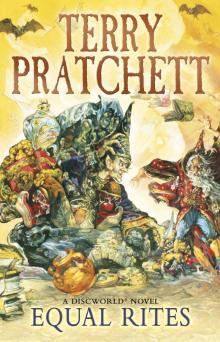 Equal Rites
Equal Rites A Hat Full of Sky
A Hat Full of Sky The Light Fantastic
The Light Fantastic Mrs Bradshaw's Handbook
Mrs Bradshaw's Handbook Wyrd Sisters
Wyrd Sisters Soul Music
Soul Music Small Gods
Small Gods Sourcery
Sourcery Reaper Man
Reaper Man Night Watch
Night Watch Lords and Ladies
Lords and Ladies The Fifth Elephant
The Fifth Elephant Monstrous Regiment
Monstrous Regiment The Truth
The Truth Witches Abroad
Witches Abroad Eric
Eric Going Postal
Going Postal Men at Arms
Men at Arms Jingo
Jingo The Amazing Maurice and His Educated Rodents
The Amazing Maurice and His Educated Rodents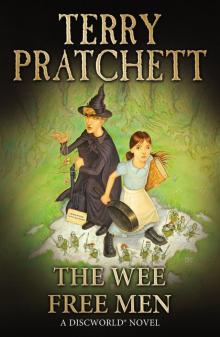 The Wee Free Men
The Wee Free Men Pyramids
Pyramids Wintersmith
Wintersmith Moving Pictures
Moving Pictures Carpe Jugulum
Carpe Jugulum Interesting Times
Interesting Times Maskerade
Maskerade Making Money
Making Money The Shepherd's Crown
The Shepherd's Crown Hogfather
Hogfather Troll Bridge
Troll Bridge The Last Continent
The Last Continent The Sea and Little Fishes
The Sea and Little Fishes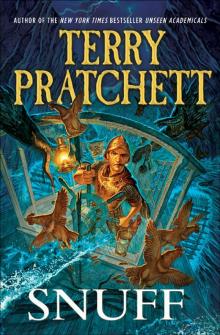 Snuff
Snuff Unseen Academicals
Unseen Academicals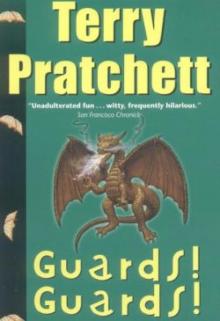 Guards! Guards! tds-8
Guards! Guards! tds-8 Jingo d-21
Jingo d-21 Turtle Recall: The Discworld Companion ... So Far
Turtle Recall: The Discworld Companion ... So Far The Fifth Elephant d-24
The Fifth Elephant d-24 Discworld 39 - Snuff
Discworld 39 - Snuff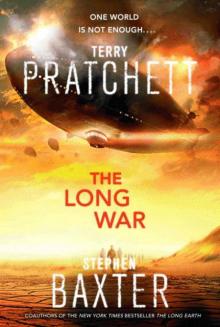 The Long War
The Long War Only You Can Save Mankind
Only You Can Save Mankind The Science of Discworld III - Darwin's Watch tsod-3
The Science of Discworld III - Darwin's Watch tsod-3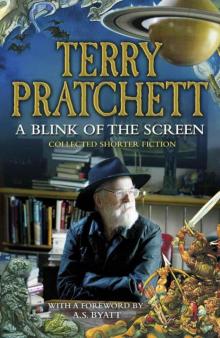 A Blink of the Screen: Collected Short Fiction
A Blink of the Screen: Collected Short Fiction Unseen Academicals d-37
Unseen Academicals d-37 Wings
Wings Making Money d-36
Making Money d-36 A Blink of the Screen
A Blink of the Screen Johnny and the Bomb
Johnny and the Bomb Dodger
Dodger Strata
Strata Discworld 02 - The Light Fantastic
Discworld 02 - The Light Fantastic The Folklore of Discworld
The Folklore of Discworld The Science of Discworld
The Science of Discworld The Unadulterated Cat
The Unadulterated Cat Raising Steam: (Discworld novel 40) (Discworld Novels)
Raising Steam: (Discworld novel 40) (Discworld Novels) The World of Poo
The World of Poo Discworld 05 - Sourcery
Discworld 05 - Sourcery The Witch's Vacuum Cleaner: And Other Stories
The Witch's Vacuum Cleaner: And Other Stories The Science of Discworld II - The Globe tsod-2
The Science of Discworld II - The Globe tsod-2 Small Gods: Discworld Novel, A
Small Gods: Discworld Novel, A Men at Arms tds-15
Men at Arms tds-15 Tama Princes of Mercury
Tama Princes of Mercury The Last Hero (the discworld series)
The Last Hero (the discworld series) The Long Utopia
The Long Utopia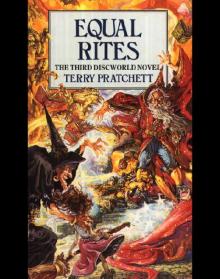 Discworld 03 - Equal Rites
Discworld 03 - Equal Rites Terry Pratchett - The Science of Discworld
Terry Pratchett - The Science of Discworld The Long Earth
The Long Earth The Carpet People
The Carpet People The Sea and Little Fishes (discworld)
The Sea and Little Fishes (discworld)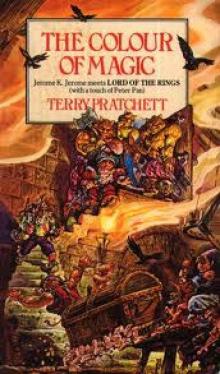 The Colour of Magic
The Colour of Magic Discworld 16 - Soul Music
Discworld 16 - Soul Music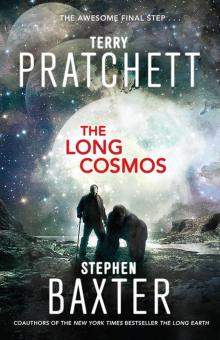 The Long Cosmos
The Long Cosmos The Dark Side of the Sun
The Dark Side of the Sun Monstrous Regiment tds-28
Monstrous Regiment tds-28 The Bromeliad 3 - Wings
The Bromeliad 3 - Wings Dragons at Crumbling Castle: And Other Stories
Dragons at Crumbling Castle: And Other Stories Night Watch tds-27
Night Watch tds-27 The Science of Discworld I tsod-1
The Science of Discworld I tsod-1 The Bromeliad 1 - Truckers
The Bromeliad 1 - Truckers The Science of Discworld Revised Edition
The Science of Discworld Revised Edition The Abominable Snowman
The Abominable Snowman Father Christmas’s Fake Beard
Father Christmas’s Fake Beard The Bromeliad Trilogy
The Bromeliad Trilogy A Slip of the Keyboard
A Slip of the Keyboard The Wee Free Men d(-2
The Wee Free Men d(-2 Johnny and the Dead
Johnny and the Dead Mrs Bradshaw's Handbook (Discworld Novels)
Mrs Bradshaw's Handbook (Discworld Novels) Truckers
Truckers The Amazing Maurice and His Educated Rodents d(-1
The Amazing Maurice and His Educated Rodents d(-1 Diggers
Diggers Thief of Time tds-26
Thief of Time tds-26 Science of Discworld III
Science of Discworld III Dragons at Crumbling Castle
Dragons at Crumbling Castle Nation
Nation Darwin's Watch
Darwin's Watch Interesting Times d-17
Interesting Times d-17 The Bromeliad 2 - Diggers
The Bromeliad 2 - Diggers The Science of Discworld II
The Science of Discworld II